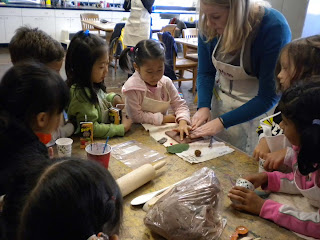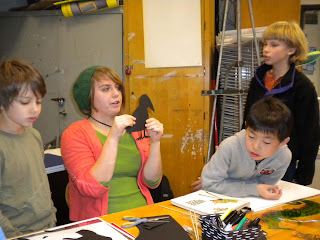
For our final class we took the time to reflect with the kids how our unit on relationships grew.
We did so by having a discussion with the kids on how we moved from lesson to lesson and what we learned.
It was great to hear the kids responding to questions with ease for the most part.
It seemed as though the kids really understood the concepts that we had been trying to get across to them.
To continue our reflection, the kids rotated through three tables where they did collaborative drawings.
Each table/ collaborative drawing was designated to a specific type of relationship we had covered – Relationships with Others, Relationships with Ourselves, and Relationships with the Environment.
It was great to see the kids interacting with one another and clearly demonstrating what they had learned through drawing.

I couldn't help but to think back to the first day of Saturday School when the students were more timid and unsure about one another. You would of never thought that they were that way from the way they were interacting and sharing their drawings today. I also thought about how student-teacher and teacher-teacher relationships have grown. We as teachers have grown to know the personalities of the students and the students themselves very well. We learned how to dodge meltdowns and how to prepare the lessons and class for the students needs to be reached. For the teacher-teacher relationships, I personally think that we became a strong and effective unit that helped each other become more successful as teachers. We were able to communicate effectively to one another and work through problems as well as share successes.
A trip to the Palmer was made for the second half of class. We split into three groups and went on a scavenger hunt to find art pieces that dealt with our lessons. The kids had fun meandering through the museum and searching for the art. I found it surprising how most of the kids were telling me about the art pieces for some of them already knew the background stories. They were eager to tell me what they knew and point things out in many of the paintings. Seeing the art put things into perspective for the kids. They found it amazing how the Calder mobile was moving and the themes of relationships can pop out in art.

 Grace continues adds some finishing touches to her vest
Grace continues adds some finishing touches to her vest












 enthusiasm to explain who [The Monster that_______] really is. The miniature books acted as more of a work space for the detectives rather than 'final products' while still allowing the detectives to feel very accomplished at the end of the class. These miniature books also served as a brainstorming activity for their large scale [profiles] they will be creating for their large book collaborative project next week.
enthusiasm to explain who [The Monster that_______] really is. The miniature books acted as more of a work space for the detectives rather than 'final products' while still allowing the detectives to feel very accomplished at the end of the class. These miniature books also served as a brainstorming activity for their large scale [profiles] they will be creating for their large book collaborative project next week.






